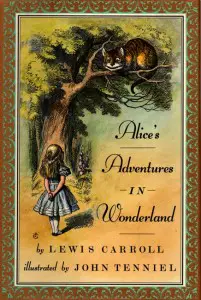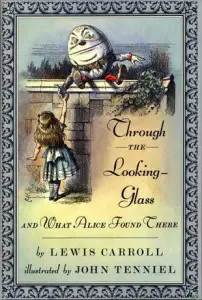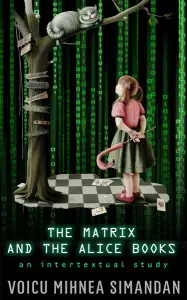 Alice’s Adventures in Wonderland by Lewis Carroll, together with its sequel, Through the Looking-Glass, are two of the most puzzling books of all time, considered to be “the most popular children’s classic in the English language” (Cohen 1995: xix). Both are children’s fantasy books (Wells 1993) with a content and style that have often appealed as much to adult readers as to the young.
Alice’s Adventures in Wonderland by Lewis Carroll, together with its sequel, Through the Looking-Glass, are two of the most puzzling books of all time, considered to be “the most popular children’s classic in the English language” (Cohen 1995: xix). Both are children’s fantasy books (Wells 1993) with a content and style that have often appealed as much to adult readers as to the young.
Lewis Carroll was born Charles Lutwidge Dodgson in Daresbury, Cheshire, on January 27, 1832. He was educated at Rugby and at Christ Church College, University of Oxford, and become a member of the faculty of mathematics at Oxford. He was the author of several mathematical treatises, including one called Euclid and His Modern Rivals (1879). The publication of the Alice books was followed by Phantasmagoria and Other Poems (1869), The Hunting of the Snark (1876), and a novel in two volumes, Sylvie and Bruno (1889-93).
Always a friend of children, particularly little girls, Carroll wrote thousands of letters to them, delightful flights of fantasy, many illustrated with little sketches. Carroll gained an additional measure of fame as an amateur photographer. Most of his camera portraits were of children in various costumes and poses, including nude studies, but he did portraits of adults too. Apparently, because his posing of children was criticized, he abandoned photography in 1880. He died at Guildford, Surrey, on January 14, 1898.
Alice’s Adventures in Wonderland was published in 1865. It was written with a particular child in mind, Alice Liddell, a daughter of Henry George Liddell, Dean of Christ Church College, and had the working title Alice’s Adventures Under Ground. As suggested by the title, it is indeed a tale of a trip beneath the normal level of existence. Alice follows a certain White Rabbit down a rabbit hole from the riverside in a dream. This alternate reality has its own internal logic. This logic is played out by now well-known characters such as the Mad Hatter, the Queen of Hearts, the Mock Turtle, the Cheshire Cat, the Caterpillar, and the March Hare whose tea parties and games have taken their place in the folklore of the real world through generations of readers. Unusual for 19th century children’s literature, the story has no moral dimension to speak of, but it does preach caution and other common sense values in the choices made by Alice that take her deeper into the wonderland.
 Through the Looking-Glass was published in 1872, seven years after Alice’s Adventures in Wonderland. The same absence of a moral to drive the story and the dream like atmosphere are two of the basic elements that echo the previous book. Alice, continuing her slumber journey, walks through a mirror into the Looking-Glass House. Reality is thus twisted, and nothing can be trusted. She meets a series of characters, now familiar to most, Tweedledum, Tweedledee, and the Walrus being just a few examples. These characters have become so much part of our language that they can be found in dictionaries. Many of Carroll’s words may seem like nonsense to us, but may have held more meaning for Victorians reading his books (Gardner 2000: 196). At the end of the story Alice changes the red queen into a kitten, overlapping with her real life where she had fallen asleep playing with different colored cats.
Through the Looking-Glass was published in 1872, seven years after Alice’s Adventures in Wonderland. The same absence of a moral to drive the story and the dream like atmosphere are two of the basic elements that echo the previous book. Alice, continuing her slumber journey, walks through a mirror into the Looking-Glass House. Reality is thus twisted, and nothing can be trusted. She meets a series of characters, now familiar to most, Tweedledum, Tweedledee, and the Walrus being just a few examples. These characters have become so much part of our language that they can be found in dictionaries. Many of Carroll’s words may seem like nonsense to us, but may have held more meaning for Victorians reading his books (Gardner 2000: 196). At the end of the story Alice changes the red queen into a kitten, overlapping with her real life where she had fallen asleep playing with different colored cats.
The Alice books, which have made the name of Lewis Carroll famous throughout the world, have been translated into many languages. On their first publication, the works, illustrated by the English cartoonist John Tenniel, became immediately popular as books for children.
Resources:
- Cohen, N.M. (1995) Lewis Carroll: A Bibliography. London: Macmillan.
- Gardner, M. (ed.) (2000) The Annotated Alice. London: Penguin.
- Wells, E. (1993) Fantasy or Reality?
(Fragment from The Matrix and the Alice Books by Voicu Mihnea Simandan, p.40-42)
 My intertextual study The Matrix and the Alice Books looks at the way Lewis Carroll’s Alice’s Adventures in Wonderland and Through the Looking-Glass have influenced some of the ideas put forth by Andy and Larry Wachowski. The book is now available as a Kindle ebook too.
My intertextual study The Matrix and the Alice Books looks at the way Lewis Carroll’s Alice’s Adventures in Wonderland and Through the Looking-Glass have influenced some of the ideas put forth by Andy and Larry Wachowski. The book is now available as a Kindle ebook too.

